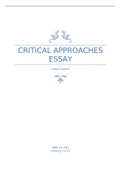CRITICAL APPROACHES
ESSAY
Sasha Campbell
APRIL 21, 2021
SHAMBOLIC O’CLOCK
;)
, An exploration of slavery’s ‘slow violence’ and its impacts on Antoinette and other white creoles in
Rhys’s Wide Sargasso Sea.
I am going to provide a meditation on Jean Rhys’s daring and unconventional novel Wide Sargasso
Sea. My reflection will focus upon the slow violence of slavery, exploring its insidious impacts upon
Antoinette and other white creoles in the text.
Nixon, who coined the term ‘slow violence’, describes it as ‘a violence of delayed destruction that is
dispersed across time and space, an attritional violence that is typically not viewed as violence at
all.’1 Although Nixon’s exploration centres on environmental catastrophe - the gradual imperceptible
destruction of our planet - I argue that slavery is also a form of slow violence. After all, the violence
of slavery, despite being ‘tidily bookended in the historical record’, extended far beyond its
abolition; in fact, its devastating effects crossed decades and generations, races and seas. 2 Alas, in a
society that values the spectacular, the explosive, the sensationally visible, the gradually unfolding
violence of slavery fades from view. Rapidly, victims of slow violence are forgotten. Meanwhile,
belated casualties of slow violence (such as Sargasso Sea’s protagonist, Antoinette) are seldom
recognised in the first place.
Wide Sargasso Sea is set in Jamaica during the ‘nineteenth-century dismantling of the British
Empire.’3 It is against this turbulent backdrop that Rhys highlights the frequently forgotten victims of
slavery and the elusive nature of slow violence. When Antoinette passes a village named Massacre,
for example, her new husband asks: ‘“And who was massacred here? Slaves?”’ and Antoinette
replies ‘“something must have happened a long time ago. Nobody remembers that now”’ (39). Both
Rochester and Antoinette appear to forget the 1674 murder of enslaved Caribs. They remain
resolute in their amnesia about the changeover between slavery and emancipation, longing to
suppress the feelings of guilt and shame that accompany memories of slavery. 4 ‘“Does it matter”’
that Antoinette and Rochester have forgotten (consciously or unconsciously) “about all these things
that happened long ago?” (8). Yes, Rhys suggests, in her sensitive reconstruction of the forgotten
past of Bertha mason (the ‘madwoman in the attic’ from Bronte’s Jane Eyre).5 And yes, Nixon seems
to agree, in his assertion that in the wide gap between the beginning of slow violence (in this case
that of slavery) and its delayed impacts, ‘both the causes and the memory of catastrophe readily
fade from view as the casualties incurred typically pass untallied and unremembered.’ 6 The
landscape, however, is unforgetting; the concealed roads, collapsing houses and silenced tales of
Granbois reflecting the scarred psyches of both plantation owners (like Antoinette) and of slaves. 7
1
Rob Nixon, Slow Violence and the Environmentalism of the Poor (London: Harvard University Press, 2011), p.
2 < https://ebookcentral.proquest.com/lib/suss/detail.action?docID=3300958# > [accessed 21 May 2021].
2
ibid., 13.
3
Victoria Burrows, Whiteness and Trauma : The Mother-Daughter Knot in the Fiction of Jean Rhys, Jamaica
Kincaid and Toni Morrison (Palgrave Macmillan Limited, 2004), p. 9
<https://ebookcentral.proquest.com/lib/suss/detail.action?docID=343794.> [accessed 21 May 2021].
4
Francis Wyndham. Introduction. Wide Sargasso Sea, Jean Rhys (London: Penguin Random House, 2016), p.
xv.
5
Kristien Hemmerechts, A Plausible Story and a Plausible Way of Telling It, A Structuralist Analysis of Jean
Rhys’s Novels (Berne: Peter Lang, 1986), p. 21.
6
Nixon, Slow Violence, p. 9.
7
Francis Wyndham, introduction, p. xx.





